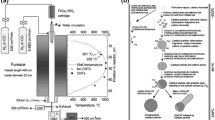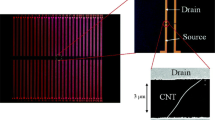Abstract
A self-assembled convective setup was utilized to manufacture multiwall carbon nanotube (MWCNTs) thin films at room temperature on glass substrates. The extracted X-ray diffraction patterns revealed that the manufactured MWCNTs films have a crystal structure with observed peaks at 2θ = 26.61°, 43.45°, and 53.1°, and are related to the (002), (101) and (004) planes, respectively, confined to graphite of a hexagonal structure. The Raman spectroscopic behavior of the samples was investigated, and the intensity of the D:G band ratio was utilized to estimate the crystallinity degree of carbon in the MWCNTs samples (~ 0.81). The SEM images of the films showed that the topographical properties of the films are retained and densely packed, confirming a network distribution. Briefly, the films are significantly influenced to have a rod-like shape of the MWCNTs. The analyzed HR-TEM images of the films have a uniform structure with cylindrical-shaped MWCNTs. When the energy of the probe waves was ~ 3.95 eV, the reflected and transmitted probe wave vanished. The fabricated MWCNTs films may play an essential role as a real absorber with an absorption coefficient α(hυ = 3.5 eV) ≈ 5.36 × 105 cm−1. The manufactured MWCNTs films are found to support the interpretation of a direct bandgap; the evaluated energy gap is \({E}_{g}^{OPT}\) =3.748 eV as a result of the carbon atoms impurities; and a direct transition at low energy is estimated by \({E}_{g}^{Onset}=0.59 \mathrm{e}\mathrm{V}\). The performance of the fabricated films is predicted and analyzed by the complex parameters: dispersion, n*, optical dielectric, ε*, and optical conductivity, σ*. The manufactured MWCNTs provide a pathway to fabricate a broadband stable behavioral absorptive layer for photovoltaic devices and optical switching optoelectronics (at low reflectance and transmittance with high absorbance).








Similar content being viewed by others
References
M. Pumera, The electrochemistry of carbon nanotubes: fundamentals and applications. Chemistry (2007). https://doi.org/10.1002/chem.200900421
M.A. Basit, M.S.U. Malik, G.U. Rehman, F.S. Awan, L.A. Khan, T. Subhani, Incorporation of carbon nanotubes on strategically de-sized carbon fibers for enhanced interlaminar shear strength of epoxy matrix composites. J. Chem. Soc. Pak. 41, 655 (2019)
J. Robertson, Realistic applications of CNTs. Mater. Today 7(10), 46–52 (2004)
P. Merel, J.B.A. Kpetsu, C. Koechlin, S. Maine, R. Haidar, J.L. Pelouard, A. Sarkissian, M.I. Ionescu, X. Sun, P. Laou, S. Paradis, Infrared sensors based on multi-wall carbon nanotube films. Comptes Rendus Phys. 11, 375–380 (2010)
Á. Kukovecz, R. Smajda, M. Oze, H. Haspel, Z. Kónya, I. Kiricsi, Pyroelectric temperature sensitization of multi-wall carbon nanotube papers. Carbon 46, 1262–1265 (2008)
J.H. Lehman, K.E. Hurst, A.M. Radojevic, A.C. Dillon, R.M. Osgood Jr., Multiwall carbon nanotube absorber on a thin-film lithium niobate pyroelectric detector. Opt. Lett. 32, 772–774 (2007)
G. Bieszczad, M. Kastek, Measurement of thermal behavior of detector array surface with the use of microscopic thermal camera. Metrol. Meas. Syst. 18, 679–690 (2011)
J. Lehman, C. Yung, N. Tomlin, D. Conklin, M. Stephens, Carbon nanotube-based black coatings. Appl. Phys. Rev. 5, 011103 (2018)
F. Wang, D. Kozawa, Y. Miyauchi, K. Hiraoka, S. Mouri, Y. Ohno, K. Matsuda, Considerably improved photovoltaic performance of carbon nanotube-based solar cells using metal oxide layers. Nat. Commun. 6, 6305 (2015). https://doi.org/10.1038/ncomms7305
R. Zhang, Y. Zhang, F. Wei, Horizontally aligned carbon nanotube arrays: growth mechanism, controlled synthesis, characterization, properties and applications. Chem. Soc. Rev. 46, 3661 (2017)
J. Lehman, A. Sanders, Very black infrared detector from vertically aligned carbon nanotubes and electric-field poling of lithium tantalate. Nano Lett. 10, 3261–3266 (2010). https://doi.org/10.1021/nl100582j
O. Pitkänen, T. Järvinen, H. Cheng, G.S. Lorite, A. Dombovari, L. Rieppo, S. Talapatra, H.M. Duong, G. Tóth, K.L. Juhász, Z. Kónya, A. Kukovecz, P.M. Ajayan, R. Vajtai, K. Kordás, Sci. Rep. 7, 16594 (2017). https://doi.org/10.1038/s41598-017-16604-x
Y. Meng, X.B. Xu, H. Li, Y. Wang, E.X. Ding, Z.C. Zhang, H.Z. Geng, Optimisation of carbon nanotube ink for large-area transparent conducting films fabricated by controllable rod-coating method. Carbon 70, 103–110 (2014).
Yu LePing, C. Shearer, J. Shapter, Recent development of carbon nanotube transparent conductive films. Chem. Rev. 116, 13413–13453 (2016)
N. Imazu, T. Fujigaya, N. Nakashima, Fabrication of flexible transparent conductive films from long double-walled carbon nanotubes. Sci. Technol. Adv. Mater. 15, 025005 (2014)
A. Venkataraman, E.V. Amadi, Y. Chen, C. Papadopoulos, Carbon nanotube assembly and integration for applications. Nanoscale Res. Lett. 14, 220 (2019)
T. Kitano, Y. Maeda, T. Akasaka, Preparation of transparent and conductive thin films of carbon nanotubes using a spreading/coating technique. Carbon 47, 3559–3565 (2009)
N.T. Dinh, E. Sowade, T. Blaudeck, S. Hermann, R.D. Rodriguez, D.R. Zahn, S.E. Schulz, R.R. Baumann, O. Kanoun, High-resolution inkjet printing of conductive carbon nanotube twin lines utilizing evaporation-driven self-assembly. Carbon 96, 382–393 (2016)
Y. Zhou, R. Azumi, Carbon nanotube based transparent conductive films: progress, challenges, and perspectives. Sci. Technol. Adv. Mater. 17, 493–516 (2016)
K.-U. Jan, Transparent MWCNT thin films fabricated by using the spray method. J. Korean Inst. Electr. Electron. Mater. Eng. 23, 338 (2010)
M. Farbod, A. Zilaie, I. Kazeminezhad, Carbon nanotubes length optimization for preparation of improved transparent and conducting thin film substrates. J. Sci. 2, 99–104 (2017)
C. Farcau, N.M. Sangeetha, H. Moreira, B. Viallet, J. Grisolia, D. Ciuculescu-Pradines, L. Ressier, High-sensitivity strain gauge based on a single wire of gold nanoparticles fabricated by stop-and-go convective self-assembly. ACS Nano 5(9), 7137–7143 (2011). https://doi.org/10.1021/nn201833y
A.M. Nawar, A. El-Mahalawy, M, Simple processed semi-transparent Schottky diode based on PMMA-MWCNTs nanocomposite for new generation of optoelectronics. Synth. Metals 255, 116102 (2019)
A.M. Nawar, M.M. Makhlouf, Bi-functional platform for non-volatile memory and photoconductive Schottky devices based on multi-walled carbon nanotubes: Rhodamine B/silicon hybrid heterostructure. Physica E 113, 54–64 (2019)
M.M. El-Nahass, H.A. El-Khalek, A.M. Nawar, Topological, morphological and optical properties of Gamma irradiated Ni (II) tetraphenyl porphyrin thin films. J. Opt. Commun. 285, 1872–1881 (2012)
R. Tsu, W.E. Howard, L. Esaki, Phys. Rev. 172, 779 (1968)
A.M. Nawar, I.S. Yahia, Fabrication and characterization of anthracene thin films for wide scale organic optoelectronic applications based on linear/nonlinear analyzed optical dispersion parameters. Opt. Mater. 70, 1–10 (2017)
A.M. Nawar, Fast processed crystalline methyl violet-6B thin films for optimizing the light-harvesting characteristics of Ag/methyl violet 6B/p-Si/Al solar cells. Appl. Phys. A 125, 210 (2019)
K. Kamarás, Á. Pekker, M. Bruckner, F. Borondics, A.G. Rinzler, D.B. Tanner, M.E. Itkis, R.C. Haddon, Y. Tan, D.E. Resasco, Wide-range optical spectra of carbon nanotubes: a comparative study. Phys. Status Solidi 245(10), 2229–2232 (2008). https://doi.org/10.1002/pssb.200879647
J.H. Lehman, M. Terrones, E. Mansfield, K.E. Hurst, V. Meunier, Evaluating the characteristics of multiwall carbon nanotubes. Carbon 49, 2581–2602 (2011)
M. Younas, M.A. Gondal, M.A. Dastageera, K. Harrabi, Efficient and cost-effective dye-sensitized solar cells using MWCNT-TiO2 nanocomposite as photoanode and MWCNT as Pt-free counter electrode. Sol. Energy 188, 1178–1188 (2019)
H.A. Maddah, V. Berry, S.K. Behura, Biomolecular photosensitizers for dye-sensitized solar cells: recent developments and critical insights. Renew. Sustain. Energy Rev. 121, 109678 (2020)
F. Abeles, M.L. Theye, Surf. Sci. 5, 325 (1966)
I. Konstantinov, T. Babeva, S. Kitova, Appl. Opt. 37(19), 4260 (1998)
O.S. Heavens, in Physics of Thin Films, ed. by G. Hass, R. Thus (Academic, New York, 1964), p. 193
M.S. Dresselhaus, A. Jorio, R. Saito, Characterizing graphene, graphite, and carbon nanotubes by Raman spectroscopy. Annu. Rev. Condens. Matter Phys. 1, 89–108 (2010)
S. Dhall, N. Jaggi, R. Nathawat, Functionalized multiwalled carbon nanotubes based hydrogen gas sensor. Sens. Actuators A 201, 321–327 (2013)
L. Bokobza, J. Bruneel, M. Couzi, Chem. Phys. Lett. 590, 153–159 (2013)
R.A. DiLeo, B.J. Landi, R.P. Raffaelle, Purity assessment of multiwalled carbon nanotubes by Raman spectroscopy. J. Appl. Phys. (2007). https://doi.org/10.1063/1.2712152
K.K. Kim, J.S. Park, S.J. Kim, H.Z. Geng, K.H. An, C.-M. Yang, Dependence of Raman spectra G' band intensity on metallicity of single-wall carbon nanotubes. Phys. Rev. B (2007). https://doi.org/10.1103/PhysRevB.76.205426
P. Mahanandia, P.N. Vishwakarma, K.K. Nanda, V. Prasad, S.V. Subramanyam, S.K. Dev, P.V. Satyam, Multiwall carbon nanotubes from pyrolysis of tetrahydrofuran. Mater. Res. Bull. 41, 2311–2317 (2006)
A. Abouelsayed, W.H. Eisa, M. Dawy, A. Shabaka, Ultraviolet and infrared studies of the single-walled and multi-walled carbon nanotube films with different thickness. Phys. B 483, 8–12 (2016)
Á. Pekker, F. Borondics, K. Kamarás, A.G. Rinzler, D.B. Tanner, Phys. Stat. Sol. (B) 243, 3485 (2006)
J. Bardeen, F. J. Blatt, L. H. Hall, Proceedings of the Photoconductivity Conference held at Atlantic City, ed. R. G. Breckenridge, B. R. Russell, E. E. Hahn (John Wiley, New York, 1956), p. 146.
S.H. Wemple, M. DiDomenico, Behavior of the electronic dielectric constant in covalent and ionic materials. J. Phys. Rev. B 3, 1338 (1971)
S.H. Wemple, Refractive-index behavior of amorphous semiconductors and glasses. J. Phys. Rev. B 7, 3767 (1973)
Acknowledgement
The authors express their appreciation to the Deanship of Scientific Research at King Khalid University for funding this work through research groups program under Grant Number R.G.P. 2/65/40.
Author information
Authors and Affiliations
Corresponding author
Additional information
Publisher's Note
Springer Nature remains neutral with regard to jurisdictional claims in published maps and institutional affiliations.
Rights and permissions
About this article
Cite this article
Nawar, A.M., Yahia, I.S. & Al-Kotb, M.S. Convective self-assembled processed multiwall carbon nanotube thin films for semi-transparent microelectronic applications. J Mater Sci: Mater Electron 31, 12127–12136 (2020). https://doi.org/10.1007/s10854-020-03759-z
Received:
Accepted:
Published:
Issue Date:
DOI: https://doi.org/10.1007/s10854-020-03759-z




